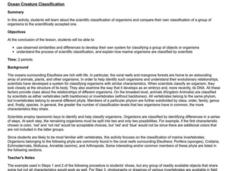Curated OER
Adopt-An-Insect Bingo
In this biology worksheet, students select twenty-five terms relating to insects to complete their bingo card as listed on the sheet. Then they match each name or family with its correct description.
Curated OER
Cloze Passage: Fishes
In this cloze passage worksheet, students read a passage and fill in blanks with words given in a word list. The passage is about fish and their characteristics.
Curated OER
Echinoderms and Invertebrate Chordates
In this echinoderms worksheet, students will read information about echinoderms and invertebrate chordates. Then students will compare their similarities and differences by completing 1 short answer question.
Curated OER
The Five Classes of Vertebrates
In this vertebrates classification activity, 5th graders unscramble 15 words to find answers to clues. Each clue gives information about the characteristics of vertebrates.
Curated OER
Insects and Bugs
Students recognize the difference between insects and bugs while making connections to personal experiences. In this insect and bug lesson, students complete a pre-assessment to demonstrate prior knowledge, then gather information...
Curated OER
Birds
In this birds worksheet, students read a 2 page informational excerpt about birds and the study of birds, ornithology. They then use the information the learned to answer the 10 questions in the packet. The answers are located on the...
Curated OER
Paleontologist: Can You Dig It?
Students investigate what a paleontologist does. They participate in a dinosaur dig, write a story, and explore the Dinosaur Dig website to view and discuss photos of a real dinosaur dig.
Curated OER
What Lives In A Shell?
Second graders study the readily observable characteristics of marine invertebrates, 2nd graders research the invertebrates and complete worksheets in this series of lessons.
Curated OER
Modeling Geologic Time
Pupils design, construct and interpret a model of geologic time and investigate change through geologic time.
Curated OER
The Chordates
Students study the characteristics of organisms that are a part of the phylum Chordata. In this organisms lesson students identify mammals that are native to Saskatchewan.
American Museum of Natural History
Saving Species
Some scientists dedicate their lives to researching and protecting endangered species. An online lesson teaches about three scientists around the world who do just that. They learn about spiders, mollusks, and reptiles from North...
Serendip
A Scientific Investigation – What Types of Food Contain Starch and Protein?
You are what you eat, as they say! Are you more starch or more protein? Young scholars use their knowledge of each component to test different foods for their content. Using multiple indicators, individuals describe the protein and...
Curated OER
The Reptiles
In this reptiles worksheet, students match 9 terms from a word list to the statement that it completes. Then students write 1 short paragraph about how they feel about reptiles.
Curated OER
Dinosaur Questions
Students discuss what scientists have learned about dinosaurs. They create as a entire class a chart that has questions for "scientists" written on it. They draw pictures of what a person might look like that is searching for answers...
Curated OER
Explorit's Bone Quiz
In this bones worksheet, students complete a ten question short answer quiz about human and animal bones. Students answer each question and self check. It appears that this is an online interactive worksheet.
Curated OER
Ocean Creature Classification
Students develop their own system for classifying a group of objects or organisms using observed similarities and differences. They investigate the process of scientific classification, and explain how marine organisms are classified by...
Curated OER
Duck Squad-Super Savers
Students "save" a rare duck (or goose, or swan) from extinction by "building" a sanctuary to protect and breed it in captivity. They research what the bird needs and draw the species and its enclosure.
Curated OER
A Study of Vertebrates
Fourth graders investigate the characteristics of each vertebrate group. They take notes in a science journal, and in small groups create a HyperStudio slideshow presentation to present information about a specific vertebrate group.
Curated OER
Aquatic Insects: Water Quality Index & Diversity Index
Students search stream beds to study the life cycle and adaptations of stream insects. They explore creeks and streams to see the diversity index of creeks or streams and to find the water qualit index.
Curated OER
Collecting Fossils
In this fossils worksheet, students will read about the hobby of fossil collecting and the tools needed for collecting fossils. Students will complete 3 short answer questions based on their reading.
Curated OER
What's A Mammal?
Students examine mammals understanding what a mammal is and reviewing the eleven mammal groups. In this science lesson, students play a game known as Mystery Mammal Game. Yet, first students research about the mammal and then give...
Curated OER
Invertebrates
In this invertebrates worksheet, high schoolers read about the characteristics of the different groups of invertebrates. Then students complete 10 multiple choice questions.
























